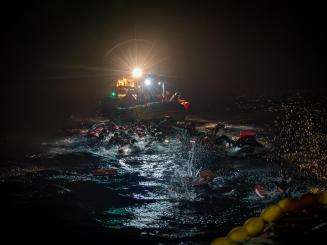Many of the countries where MSF works are already the hardest hit by climate change. In South Sudan, for example, unprecedented floods over the last four years have displaced hundreds of thousands and cut off entire communities from access to health care. Among the most vulnerable are people living in displacement camps—a camp in Bentiu, Unity State virtually became an island surrounded by floodwater during the rainy season in 2022. Today, even more people are living in camps across South Sudan, with nearly 600,000 having fled the war in Sudan over the past year. On a recent visit to the country, MSF USA president, Avril Benoît saw the effects of climate change firsthand.
At MSF, our teams are witnessing firsthand how climate change is already impacting people’s health around the world.
Last fall, I saw it myself in Old Fangak, a remote town hidden in marshlands in the northern region of South Sudan, where many people displaced by conflict have sought refuge from the fighting over the years.
But the terrain that once kept people safe has turned against them as climate change has exacerbated existing health issues and created new ones. The waters that kept conflict at bay are now an obstacle to travel, and the dense vegetation where people hid from violence has become overgrown and unruly, making accessing basic services like health care extremely difficult.
For many of those who fall ill in this area, it can take days by canoe to reach the hospital that MSF has supported in Old Fangak since 2014, which is the only hospital in an area with 20,000 people.
When I visited the hospital last fall, I met a woman who had recently made the difficult decision to flee the ongoing violence in Sudan after living there for nine years.
Nyakena gathered her six children, hopped on the bus, and hoped they would be safer in Old Fangak, a town where the only family she has is her mother-in-law. She said she hadn’t heard from her husband since September, though she believed he was still in Khartoum.
Once she reached South Sudan, she waited in line all day but didn't reach the end to be registered as a returnee to South Sudan, which is necessary to receive assistance like food and cash to help people restart their lives. Instead, she and her children made their way to Old Fangak with only what they brought with them from Sudan.
Now her two-year-old daughter, Chudier, is fighting for her life after being admitted to the hospital for malaria and malnutrition.

Here and in many other parts of the world, one of the main health issues associated with extreme flooding is malaria, since stagnant water is a breeding ground for mosquitoes. As a result, most patients we see at the hospital in Old Fangak have malaria, especially during the rainy season.
Extreme flooding also increases the chances of outbreaks of waterborne diseases like cholera and hepatitis E. In and around Old Fangak, latrines are flooded and drinking water sources are contaminated. There is an ongoing hepatitis E outbreak, which can be especially deadly for pregnant people.
Submerged land also means people cannot grow crops, and their livestock can't graze. In Old Fangak, many men have turned to fishing for themselves and their families, and women have turned to less traditional and nutritional food sources like harvesting water lilies.
While the UN World Food Program provides some food assistance, aid was recently reduced in eastern Africa amid increasing global needs, leaving children and adults more vulnerable to malnutrition.
Humanitarian needs are estimated to double by 2050. The situation for our patients is only going to get worse.
In 2022, an estimated 249 million malaria cases were reported—a number that is expected to rise by 15 million in the coming years. We’ve already seen an unprecedented rise in cholera in recent years due to climate factors like floods and droughts, conflict, and forced displacement as there is often limited access to clean water in refugee and displacement camps—a trend that is likely to continue as more and more people are forced to live in crowded conditions. And as extreme weather events continue to happen all over the globe with greater frequency and intensity, more and more people will face food insecurity and experience malnutrition.
Right now, people across the globe who are the least responsible for the greenhouse gas emissions that have caused the climate crisis are suffering the worst consequences because they have the fewest resources to adapt to their new realities and mitigate the impacts of climate change. These are often the same people and communities in which MSF works.
Going forward, governments must make concrete financial commitments to ensure that help is truly reaching those who need it most.
During my time in Old Fangak, I met a community elder who told me that everyone relies on each other to survive the flooding. Surrounding communities help each other build dikes to keep the water at a distance, and families offer up their homes to those who've been displaced so they have somewhere dry to sleep.
We must respond to the global climate emergency with this same sense of solidarity.
More from this issue of Alert
June 07 09:00 AM
The most dangerous place in the world to be a child
The impact of war on Gaza's children
Read More
April 19 01:47 PM
Saving lives is not a crime
Tommaso Fabbri, MSF’s former head of mission for search and rescue, on a legal case dismissed after seven years in limbo
Read More
June 07 09:00 AM
The journey north
Documenting struggle and determination on migration routes in the Americas
Read More
June 07 09:00 AM
One year of catastrophe in Sudan
A cross-country journey during a war that has created the largest displacement crisis in the world
Read More

Alert Summer 2024
Connecting Threads: Displacement, Conflict, and the Human Stories That Link Us




